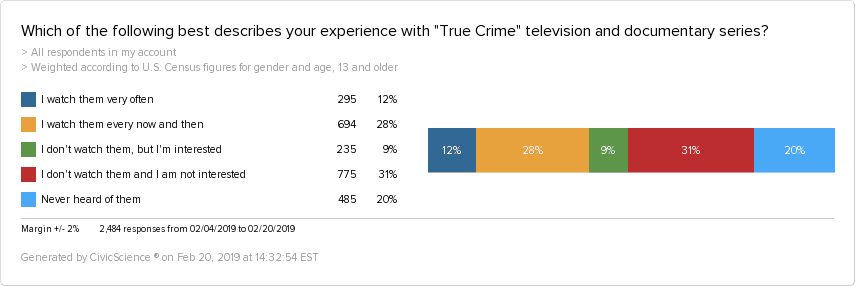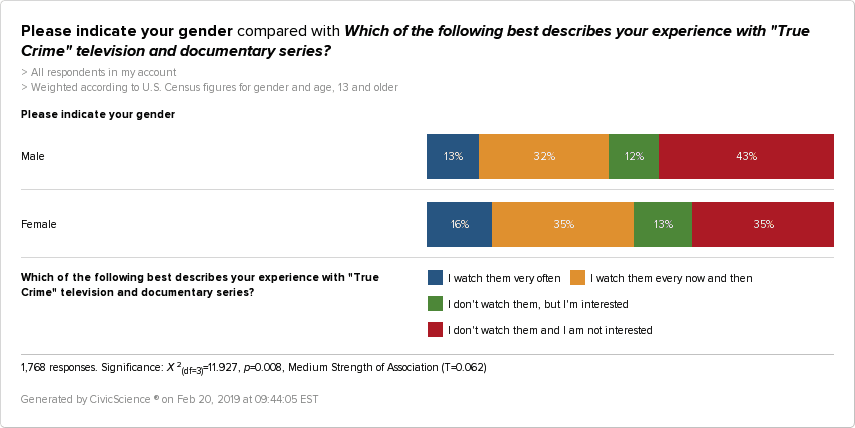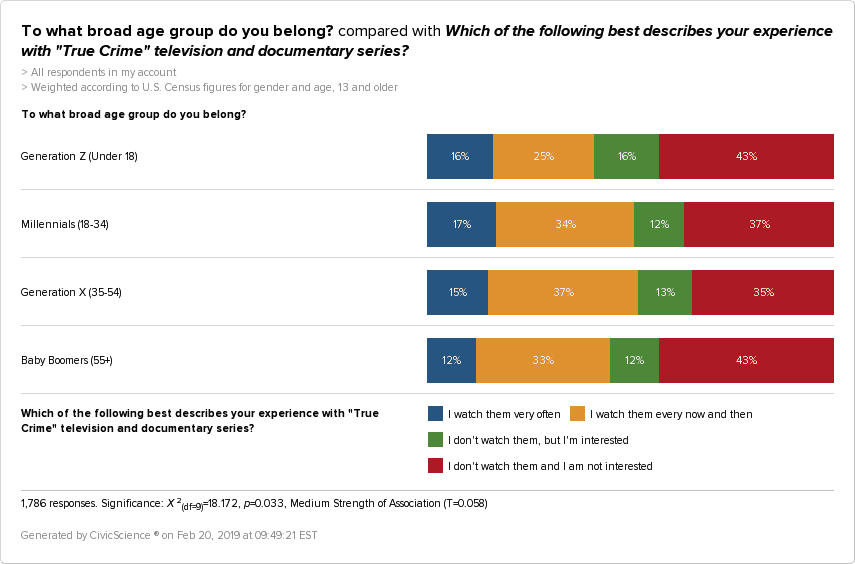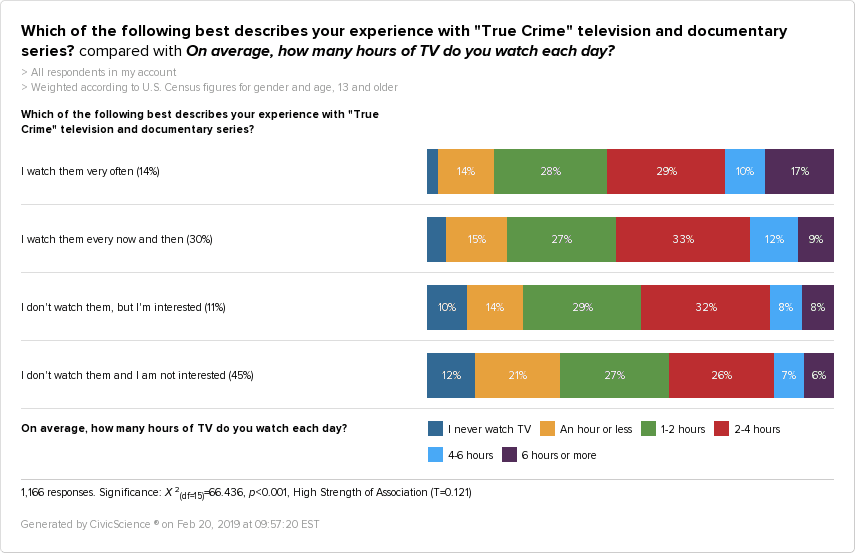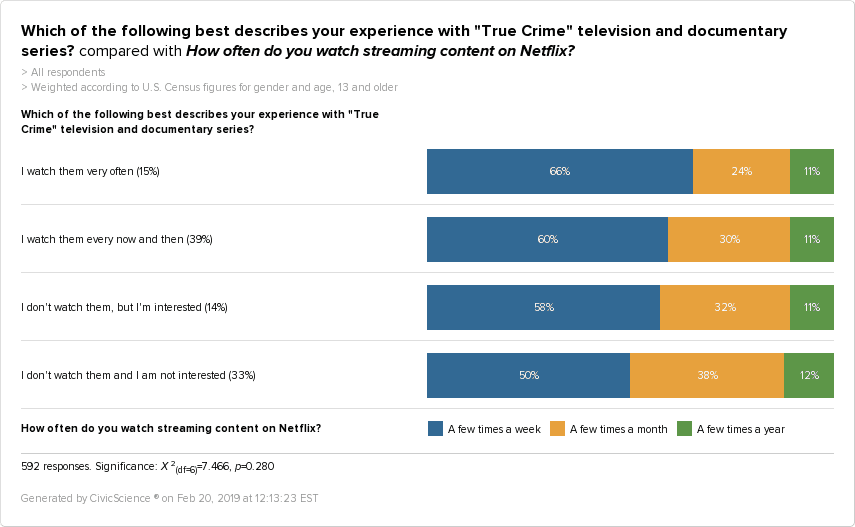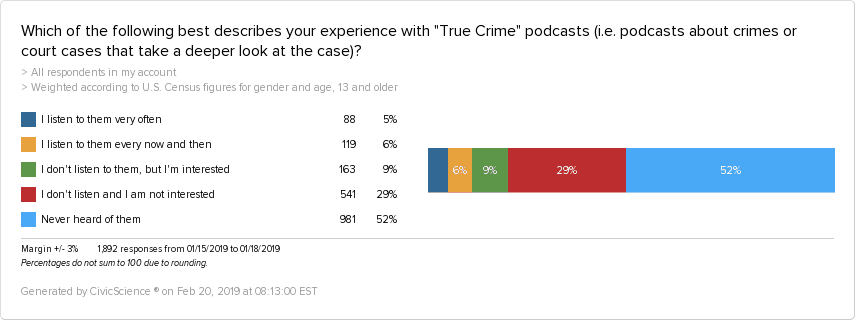Crime makes great entertainment. Although it may sound controversial, true crime series–shows that unpack and analyze past crimes–have taken the entertainment world by storm. Acquiring an almost cult-like following, this unique media niche offers noteworthy insight into what consumers are seeking, namely, fascinating stories of criminal activity. To better understand the buzz around this topic, research firm CivicScience asked over 2,000 U.S. adults about their experience with true crime television and documentary series.
According to the data, over half of U.S. respondents are at least somewhat interested in true crime, suggesting that there is a hefty interest base.
When it comes to personal experience with true crime content, 28% watch every now and then, while 12% watch very often. The 9% who are interested but haven’t yet started watching could cause the frequency percentages to increase, as they dive into these series over time.
An assessment of gender can help better characterize the target audience demographics for true crime. And, as the data shows, viewership skews female.
While Millennials and Gen Xers are the most likely to already be watching true crime content, 16% of Gen Z indicates a desire to tune in at some point in the future. However, it’s unlikely Gen Z will catch up to the age 18-54 viewership numbers, as 43% are not interested.
True Crime Takes Time
The data further reveals that those who watch true crime also tend to watch more television. Individuals who report watching true crime content often are also the most likely to watch six or more hours of television a day.
Spotlight on Streaming Services
There are almost endless options for where viewers can get a true crime fix. After asking over 2,500 respondents about the services or channels on which they consume true crime content, CivicScience found that 44% of U.S. respondents report they watch true crime somewhere, out of the given answer choices: Netflix, Amazon Prime, Hulu, HBO, NBC, ABC, CBS, ID channel, Lifetime, Oxygen, or “Other.”
However, Netflix stands out as the most popular platform for this entertainment niche.
There is also a strong correlation between those who stream content on Netflix and those who watch true crime very often, reinforcing the suggestion that true crime fans may have a preference for their on-demand services.
And true crime isn’t just a trend on Netflix. Viewers are also watching true crime on Amazon Prime.
Both of these platforms give viewers the option to not just choose what they watch, but when, where, and for how long. Whether you have time for just one episode or plan to binge-watch an entire series, true crime via a streaming service is a widely popular choice. Hulu came in third place of the three streaming services, of which 9% said they watch true crime on the platform.
Speaking of binge-watching, or watching multiple episodes of a series in one sitting, the data shows a correlation between those who consume true crime content and those who binge-watch on a weekly basis, as well as those who binge-watch several times per month.
However, true crime hasn’t just captured streaming audiences. Investigation Discovery (ID), a TV network dedicated to all things true crime, is far and away the most popular television network for catching up on the latest true crime documentary or series.
This data suggest there may be an element of specificity that appeals to true crime viewers. Whether on a streaming service or a dedicated television channel, viewers appear to want a thorough crime experience, not one that is chopped up or diluted by unrelated topics. (NBC, whose “Dateline” series is very popular, was runner up, with 10% of U.S. respondents indicating they watch crime content on the network.)
Of course, documentaries and TV series aren’t the only methods for catching up on the latest gore and cold cases. Podcasts are becoming an important media outlet for engaged listeners as well. However, at this moment, podcasts may not be the most popular medium for true crime content.
Although the percentages are low, podcasting is yet in its infancy. Those who don’t listen but are interested could be the demographic that begins to shift the tide of true crime podcast favorability in the future.
As an entertainment vertical, true crime is huge and only growing. Intent to watch, combined with those who do watch on a regular or frequent basis underscores the mass interest in this unconventionally popular topic. Given the fact that true crime is not for the faint of heart, it only makes sense that viewers prefer to stream or tune into a crime-only channel. So as interest continues to grow, it will be up to streaming services and networks to keep up with the ever-increasing demand for a crime experience that lives up to these expectations.

